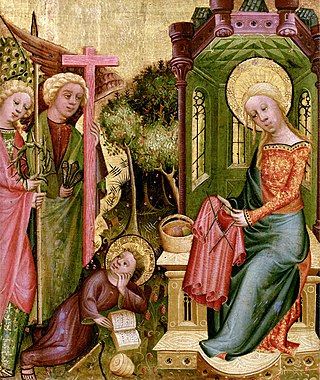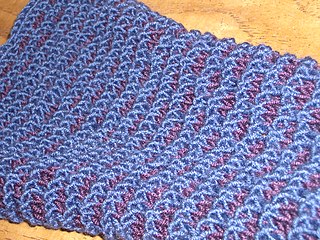
Knitting is a method for production of textile fabrics by interlacing yarn loops with loops of the same or other yarns. It is used to create many types of garments. Knitting may be done by hand or by machine.

Knitting is the process of using two or more needles to pull and loop yarn into a series of interconnected loops in order to create a finished garment or some other type of fabric. The word is derived from knot, thought to originate from the Dutch verb knutten, which is similar to the Old English cnyttan, "to knot". Its origins lie in the basic human need for clothing for protection against the elements. More recently, hand knitting has become less a necessary skill and more of a hobby.

Debbie Stoller is a New York Times best-selling American author, publisher, feminist commentator and knitting expert whose work includes magazines as well as books. She lives in Brooklyn, New York City. Stoller is the co-founder, co-owner and editor-in-chief of the culture magazine BUST, which she and Marcelle Karp launched in 1993.
English knitting, also known as right-hand knitting or throwing, is a style of Western knitting where the yarn to be knit into the fabric is carried in the right hand. This style is prevalent throughout the English-speaking world, though it is by no means universal.
The term "gauge" is used in knitting to describe the fineness size of knitting machines. It is used in both hand knitting and machine knitting. The phrase in both instances refers to the number of stitches per inch rather than the size of the finished article of clothing. The gauge is calculated by counting the stitches or needles across a number of inches, then dividing by the sample's width in inches.

Elizabeth Zimmermann was a British-born hand knitting teacher and designer. She revolutionized the modern practice of knitting through her books and instructional series on American public television.

Slip-stitch knitting is a family of knitting techniques that uses slip stitches to make multiple fabrics simultaneously, to make extra-long stitches, and/or to carry over colors from an earlier row.
The "sweater curse" or "curse of the love sweater" is a term used by knitters and crocheters to describe the belief that if a knitter or crocheter gives a hand-knit sweater to a significant other, it will lead to the recipient breaking up with the knitter. In an alternative formulation, the relationship will end before the sweater is even completed. The belief is widely discussed in knitting publications, and some knitters claim to have experienced it. In a 2005 poll, 15% of active knitters said that they had experienced the sweater curse firsthand, and 41% considered it a possibility that should be taken seriously.
Shannon Okey is an American writer and knit designer.

Stitch London is a knitting group in London, England, who meet weekly in various venues across central London to knit in public. It is also a virtual knitting group whose members join via newsletter, Facebook, Ravelry, and Twitter. Its members number in their thousands and it has a global membership despite being based in London.
A knitting club is a social group in which knitting and crochet enthusiasts gather to do needlework together. They are a feature of the 21st-century revival of hand knitting which began in America and has spread to most of Europe. Despite the name, knitting clubs are not limited to knitting; both crochet-centered and knit-centered clubs are collectively called "knitting clubs." While knitting has never gone away completely, this latest reincarnation is less about the make-do and mend of the 1940s and 1950s, and more about making a statement about individuality and developing a sense of community.
Hand knitting is a form of knitting, in which the knitted fabric is produced by hand using needles.

Ravelry is a free social networking service and website that beta-launched in May 2007. It functions as an organizational tool for a variety of fiber arts, including knitting, crocheting, spinning and weaving. Members share projects, ideas, and their collection of yarn, fiber and tools via various components of the site.
I Knit London is a knitting organisation based in London, England, UK, comprising a knitting group, knitting shop and knitting events. I Knit London was formed in December 2005, and is run, by Gerard Allt and Craig Carruthers.

Yarn bombing is a type of graffiti or street art that employs colourful displays of knitted or crocheted yarn or fibre rather than paint or chalk. It is also called wool bombing, yarn storming, guerrilla knitting, kniffiti, urban knitting, or graffiti knitting.

Cowichan knitting is a form of knitting characteristic of the Cowichan people of southeastern Vancouver Island, British Columbia. The distinctively patterned, heavy-knit Cowichan sweaters, popular among British Columbians and tourists, are produced using this method. Cowichan knitting is an acculturated art form, a combination of European textile techniques and Salish spinning and weaving methods. From this union, new tools, techniques and designs developed over the years.
Norah Gaughan is an American hand knitting pattern designer.
Arm knitting is a knitting technique which uses the knitter's arms instead of knitting needles. This method of knitting gained popularity during 2013 and 2014.

Bohus Stickning was a Swedish knitting cooperative that was active between 1939 and 1969. It was established as a cottage industry to provide income for poor families in Bohuslän (Sweden) during the Great Depression. Knitwear designed by the founder Emma Jacobsson and other designers was handknit by women in Bohuslän Province and sold to department stores, boutiques and fashion houses both in Sweden and internationally.
Clara Parkes is an American author, yarn critic, and wool expert. Parkes has been described as "quite possibly the only writer you will ever read who can make a discussion of micron counts absolutely riveting."












